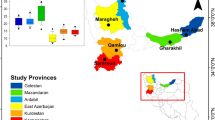Summary
The effects of water regime on the rate of growth, the growing period and the yield of a winter wheat crop in the summer-dry climate of Aegean Islands are examined. It is shown that wheat growing period is significantly restricted by either, unfavourable weather conditions at planting (coinciding with the start of rains), or by early soil moisture depletion at the end of the wet season. The probability of a successful early planting, which is conditional on a considerable pre-planting rainfall not being following by a long (10-day) dry spell, is estimated by recurrence relationships. Farmers on the driest (south) islands will have a 25% risk for unsuccessful planting before November 14. Evapotranspiration rates, estimated by the Penman-Monteith equation, are optimum for crop growth for about two months after wintering. The growing season on average comes to an end by the end of spring (soon after anthesis), when the available soil moisture. (estimated by a simple water balance equation) drops to zero.
The water shortage, especially during the grains-filling period, may reduce yields by up to 75%, depending on the length and severity of the soil moisture deficit at the site. Reliability and distribution of rainfall suggest that the risks of water deficits in rainfed cropping vary across the region. In order to minimise yield losses from crop failures, farmers should adjust areas sown each year according to the date when the wet season starts.
Similar content being viewed by others
References
Anadranistsakis, M., Liakatas, A., 1993: Eau disponible et production de culture vegetable.Publications de l' Association International de Climatologie 6, 605–612.
Betoit, P., 1977: The start of the growing season in northern Nigeria.Agric. Meteorol. 18, 91–99.
Coe, R. D., Stern, R. D., 1982: Fitting models to daily rainfall data.J. Appl. Meteor. 21/7, 1024–1031.
Davy, E. G., Mattei, F., Solomin, S. I., 1976: An evaluation of climate and water resources for development of agriculture in the Sudano-Sahelian Zone of West Africa. Special Environmental Report 9, WMO — No459, Geneva.
Doorenbos, J., Kassam, A. M., Bentvelsen, C. L. M., Branscheid, V., Plusje, J. M. G. A., Smith, M., Vittenbogoard, G. O., Van Der Wal, M. K., 1986: Yield response to water. FAO Irrigation and Drainage Paper33, Rome.
Egan, J. P., Mc Donald, G. K., 1992: Matching varieties to sowing dates — is it worthwhile? In: Proceedings of Tillage Systems, Rotations, Nutrition and Associated Root Diseases. Department of Agriculture, South Australia, Adelaide, 26–27 March 1992, pp. 43–44.
Fitzpatrick, E. A., Krishnam, A., 1967: A first order Markov model for assessing rainfall discontinuity in central Australia.Arch. Geophys. Biocl. Series B. 15, 242–259.
Gabriel, K. R., Neumann, J., 1962: A Markov chain model for daily rainfall occurrence at Tel Aviv.Quart. J. Roy. Meteor. Soc. 88, 90–95.
Gates, P., Tong, H., 1976: On Markov chain modelling to some weather data.J. Appl. Meteor. 15, 1145–1151.
Huda, A. K. S., 1994: Management strategies to minimise climatic risk to wheat production in low rainfall areas of southern Australia.Agric. Forest. Meteor. 69, 125–147.
Katz, R. W., 1977: Precipitation as a chain-dependent process.J. Appl. Meteor. 16, 671–676.
Kowal, J. M., Knabe, D. T., 1972: An Agroclimatological Atlas of the Northern Stages of Nigeria, Zaria. Nigeria: Ahmadu Bello University Press.
Liakatas, A., 1990:Radiation and photosynthesis. University of Athens Publications, Special Issue in Memorial of L. Karapiperis, 205–219, Athens, Greece.
Liakatas, A., Haradonis, T., 1988: Study and estimation of sunshine duration.Meteorlogika,73, 135–148, University of Thessaloniki Publications, Thessaloniki, Greece.
Mac Caskill, M. R., Kariada, I. K., 1992: Comparison of five water stress predictors for the tropics.Agric. Forest Meteor. 58, 19–34.
Saxton, K. E., Porter, M. A., Mc Mahon, T. A., 1992: Climatic impacts on dryland winter wheat yields by daily soil water and crop stress simulations.Agric. Forest. Meteor. 58, 177–192.
Seligman, N. G., van Keulen, H., Spitters, C. J. T., 1992: Weather, soil conditions and the interannual variability of herbage production and nutrient uptake on annual Mediterranean grasslands.Agric. Forest. Meteor. 57, 265–279.
Semevov, M. A., Porter, J. R., 1995: Climatic variability and the modelling of crop yields.Agric. Forest. Meteor. 73, 265–283.
Stephens, D. J., Walker, G. K., Lyons, T. J., 1994: Forecasting Australian wheat yields with a weighted rainfall index.Agric. Forest. Meteor. 71, 247–263.
Stern, R. D., Coe, R., 1982: The use of rainfall models in agricultural planning.Agric. Meteorol. 26, 35–50.
Stern, R. D., Dennett, M. D., Dale, I. C., 1982a: Analysing daily rainfall measurements to give agronomically useful results. I. Direct methods.Expl. Agric. 18, 223–236.
Stern, R. D., Dennett, M. D., Dale, I. C., 1982b: Analysing daily rainfall measurements to give agronomically useful results. II. A modelling approach.Expl. Agric. 18, 237–253.
Thompson, N., Barrie, I. A., Ayles, M., 1981: The Meteorological office rainfall and evaporation calculation system: MORECS. Met. 0.8 (Hydrometeorological Services).Hydrological Memorandum No.45: 6pp.
Virmani, S. M., 1975: The agricultural climate of the Hyderabat region in relation to crop planning (a sample analysis). Hyderabat, India, ICRISAT.
Vossen, P., 1990: Comparative statistical validation of two ten-day water — use models and of three yield — reduction hypotheses for yield assessment in Botswana.Agric. Forest. Meteor. 51, 177–195.
World Meteorological Organisation (WMO), 1981: Guide to Agricultural Meteorological Practices. 2nd edition, WMO-No.134, Geneva.
Author information
Authors and Affiliations
Additional information
With 10 Figures
Rights and permissions
About this article
Cite this article
Liakatas, A. Growth and yield of rainfed wheat on the seasonally dry Aegean Islands. Theor Appl Climatol 58, 43–56 (1997). https://doi.org/10.1007/BF00867431
Received:
Revised:
Issue Date:
DOI: https://doi.org/10.1007/BF00867431




